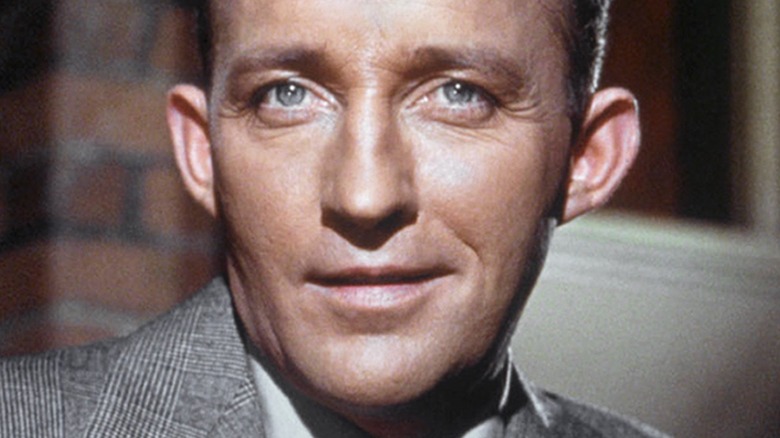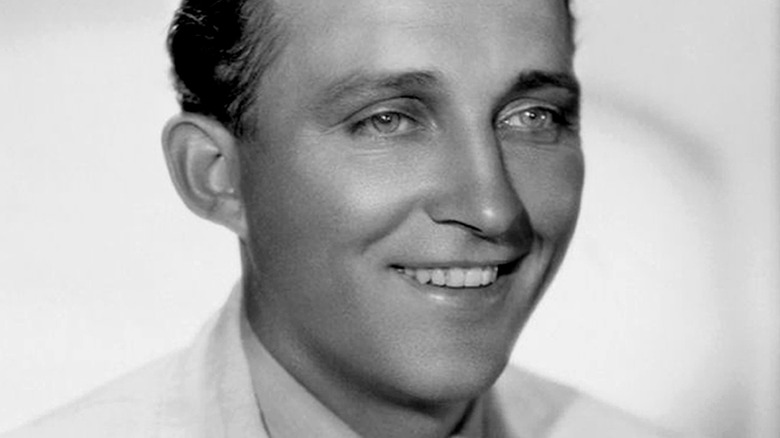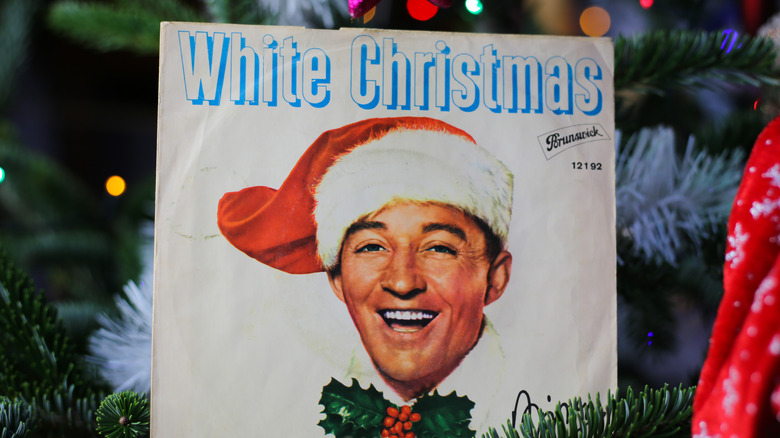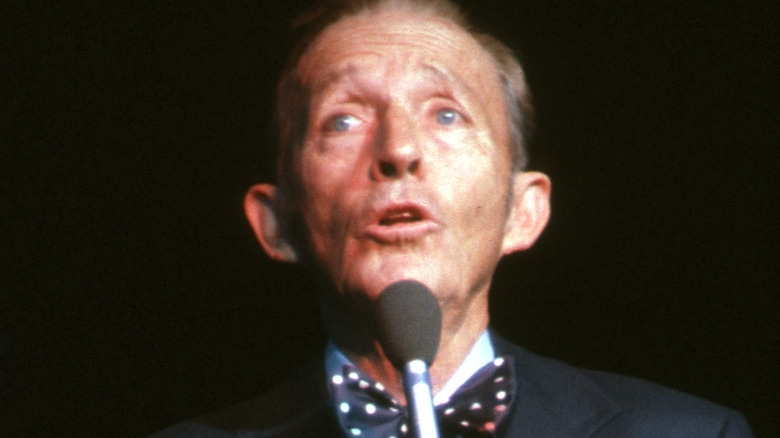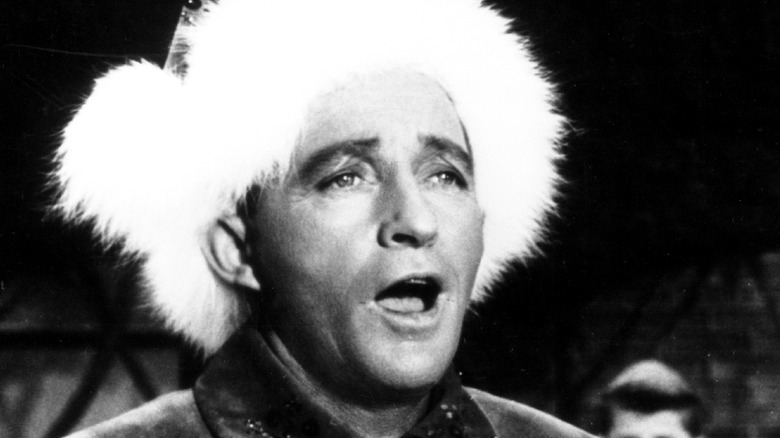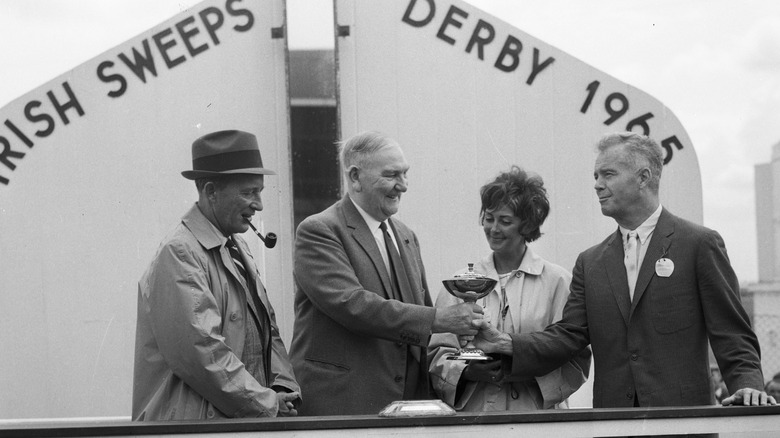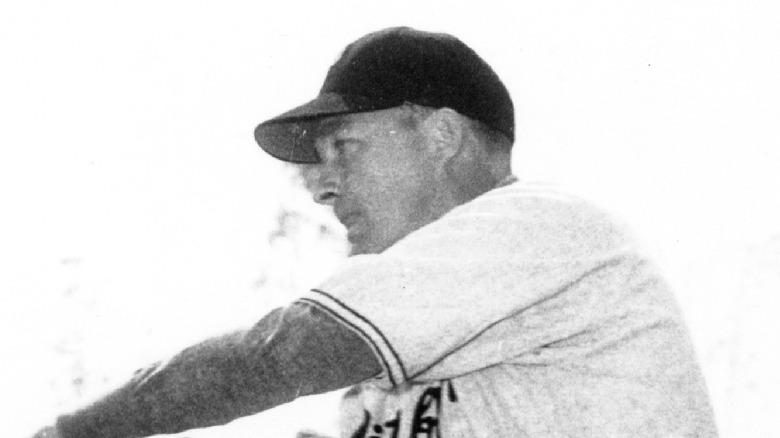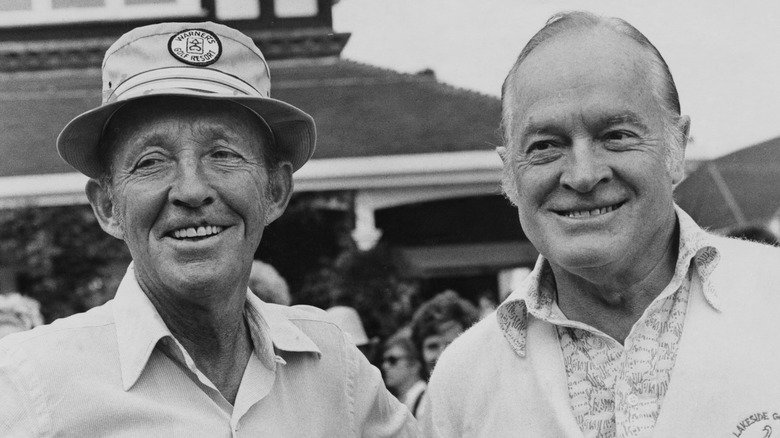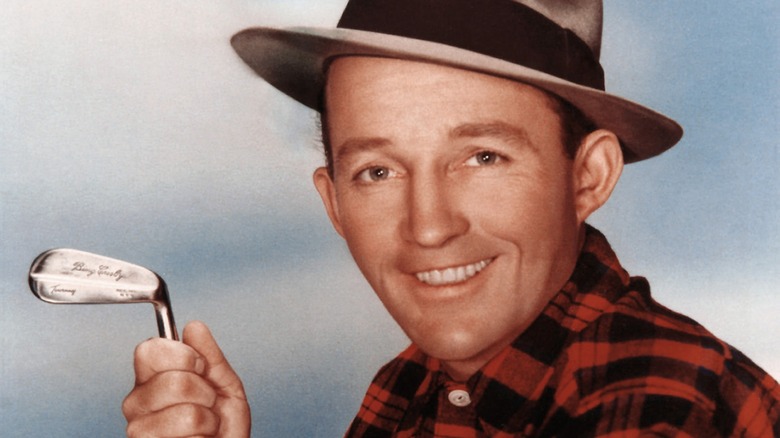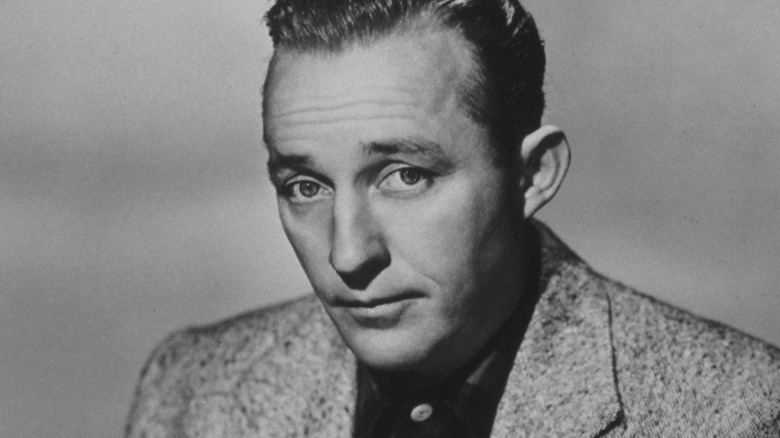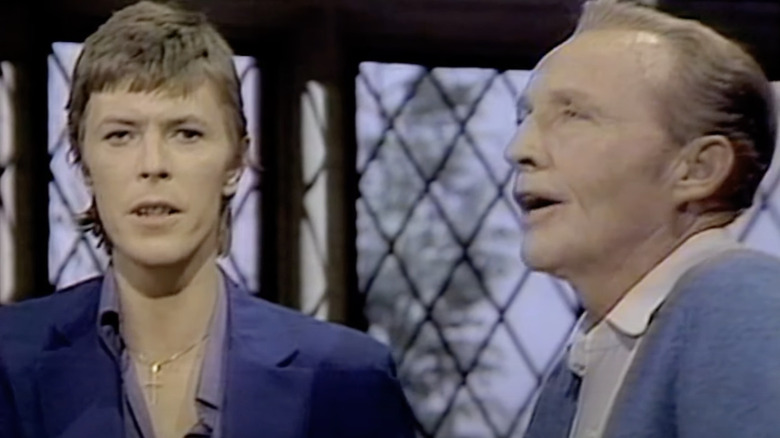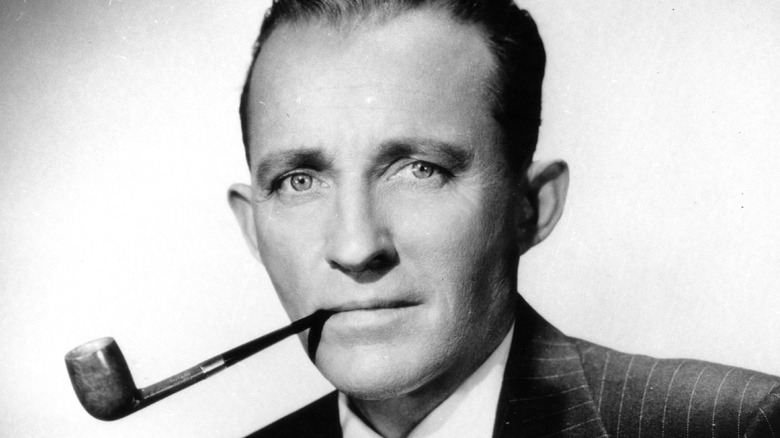The Untold Truth Of Bing Crosby
At one time in the middle of the 20th century, well, for a large chunk of that time period, there wasn't a celebrity on planet Earth more famous, successful, or beloved than Bing Crosby. A singer in the classic crooner mold, he was an interpreter of songs, bridging the big band, jazz, and traditional pop eras to make dozens of songs his own through his distinctively smooth, deep, and friendly voice. Crosby wasn't just a pop star that everyone could like — he was also a major radio performer and one of the most surefire box office stars for years. But nowadays, Crosby is likely best known for his work in helping the world celebrate and mythologize Christmas — his holiday tunes, especially "White Christmas" — are staples of December nearly 80 years after their debut.
Crosby was wildly successful in almost everything he tried, even beyond singing and acting. But he lived a complicated life not nearly as smooth as his singing style. Here's a look into the career and off-mic life of "Der Bingle," and the very voice of Christmas himself, Bing Crosby.
His name wasn't really Bing
Having a memorable, unique, musically-evocative name probably didn't hurt Bing Crosby on his march to worldwide success, fame, and fortune. However, that first name isn't one his parents gave him upon his birth. Born Harry Lillis Crosby outside of Seattle in 1903, he was raised on the other side of Washington state, in Spokane, where as a boy he and a friend in his neighborhood were big fans of a comic strip called "The Bingville Bugle," according to The Daily Chronicle. That evolved into a nickname, with the friend calling young Crosby "Bingo from Bingville," which was eventually truncated into just Bing — which stuck.
That nickname-from-a-nickname also gave rise to yet another nickname for the singer and actor. During World War II, according to "Just Remember This" by Colin Bratkovich, Crosby contributed to the Allied efforts to defeat the Nazis by participating in U.K.-based propaganda broadcasts aimed at German audiences. Despite him being part of the other side, German listeners loved Crosby and gave him the German-esque pet name "Der Bingle."
How Bing Crosby made 'White Christmas' an all-time smash
Bing Crosby's most enduring contribution to popular culture: the song "White Christmas," written by Irving Berlin. "His identity with Christmas was a strategy," Crosby's son, Nathaniel, told Billboard. "He recorded songs that were basically intended to last forever." Crosby made his first version of "White Christmas" in May 1942, and it was released that summer on the soundtrack for the singer's movie, "Holiday Inn," but took off that Christmas — the narrator's melancholic and nostalgic wish for a holiday "just like the one [he] used to know" allegorically expressed the pain of separation felt by millions of American troops and their families separated by World War II. "White Christmas" spent 11 weeks at #1 on the pop chart, won the Academy Award for Best Original Song, and returned to #1 around Christmas in 1943 and 1944, and it would become a hit again when Crosby would star in a movie called "White Christmas" in 1954. However, the version heard today (and over the past few decades) likely isn't the original version from 1942 — according to the Library of Congress, the song's original masters got worn out from being pressed so much to meet demand.
"White Christmas" makes multiple appearances in "Guinness World Records," ranking as the all-time best-selling Christmas song, single by a male artist, and single of any kind. Around the world, and accounting for all the different ways music can be bought, Crosby's version of "White Christmas" has been purchased more than 100 million times.
Bing Crosby is the king of the pop chart
Bing Crosby is remembered well into the 21st century, still a household name more than 40 years after his death, but by and large he's associated primarily with Christmas pop culture. His signature recordings of holiday standards like "White Christmas," "Mele Kalikimaka," and "It's Beginning to Look a Lot Like Christmas" are the ones that still get airplay today, but these represent just a tiny portion of Crosby's extremely voluminous and successful audio output.
According to PBS Crosby recorded more than 2,000 songs during his career, and he made a vast many of them into hit songs. Altogether, Crosby charted 396 times, and 203 of them went top 10. Nobody in American music history scored more #1 hits — he topped the pop chart 43 times (more than the Beatles and Elvis Presley put together), spending a total of 173 weeks at #1. Among the standards that Crosby popularized by making them huge hits: "Brother, Can You Spare a Dime?," "Pennies from Heaven," and "Swinging on a Star."
Crosby was so popular and had so many familiar songs that in 1948, according to Music Digest (via the Hollywood Walk of Fame), half of all the radio airplay used on recorded music was used to play his tunes. By the end of his lifetime, Crosby sold nearly a billion pieces of music and had sung on 13 Oscar-nominated songs, too.
Bing Crosby was the king of the box office
Bing Crosby lay the groundwork for a career path taken by so many musicians years after his rise, everyone from Cher to Ice Cube to Will Smith to Lady Gaga. Because not only was Bing Crosby a recording star of unparalleled and quantifiable achievement, he was also one of the biggest movie stars in Hollywood history.
According to Quigley's Motion Picture Almanac (via Bing Crosby Internet Museum), Crosby rated among the 10 highest-grossing actors in the movie industry on 15 different occasions, in a period spanning from 1934 to 1954. From 1944 to 1948 — five straight years — Crosby ranked #1 on that list. Among Crosby's big movie hits: "Holiday Inn," "White Christmas," seven "Road" movies with fellow draw "Bob Hope," and "Going My Way." His role as progressive priest Father Chuck O'Malley won Crosby the Academy Award for Best Actor. He'd be nominated in that category a year later for "The Bells of St. Mary's," a sequel to "Going My Way," making Crosby the first actor to be recognized by the Oscars more than once for the same role.
Bing Crosby was heavily involved with horse racing
Bing Crosby was highly successful in the avenues of recorded music, film, and radio, and he parlayed some of the huge fortune those fields afforded him into other forms of entertainment — he was a big financial backer in the horse racing world. According to Past the Wire, Crosby bought his first race horse early in his singing career, in 1935, and just two years later had helped found the Del Mar Thoroughbred Club and would serve on its board of directors as its Del Mar Racetrack grew into one of horse racing's biggest venues. With club co-creator and friend Lindsay Howard (after whom he named one of his sons) Crosby also co-founded Binglin Stable, which had operations in the U.S. and Argentina to breed and export horses around the world. In 1938, Crosby's club hosted a $25,000 race (Howard's horse, Seabiscuit, beat his horse, Ligaroti), which served as the inspiration for The Bing Crosby Stakes, established in 1996.
Bing Crosby saved and then lost a piece of baseball history
According to The Hollywood Reporter, Crosby played semipro baseball as a young man, and that enduring love of the game manifested as a $2.25 million buy-in for a 25% stake of the Pittsburgh Pirates in 1946. (He likely would have become a baseball owner years earlier; 1944 marked the death of baseball commissioner Kenesaw Mountain Landis, who steadfastly refused to allow anyone from horse racing, which he considered shady, from getting involved.)
The biggest moment in Crosby's tenure: The Pirates played in the 1960 World Series, which they stretched to a seventh and decisive game. Crosby, who had a knack for attending games that the Pirates lost, considered himself something of a curse on the team, so he skipped Game Seven and asked an employee to make a kinescope (a pre-videotape recording method) of the game. The Pirates won when Bill Mazeroski hit a home run at the very end of what's been nicknamed "The Best Game Ever," and no recordings of it were thought to have survived ... until 2010, when that well-preserved kinescope was found in the wine cellar of Crosby's old estate.
Bing Crosby could've been Columbo or hit the 'Road' again
Bing Crosby was almost as prolific of an actor as he was as a musician. Between 1930 and his death in the mid-1970s, he amassed more than 100 acting credits, moving from bit player to big-time movie star, to central figure of his own sitcom. Crosby didn't do much scripted work by the 1970s, when he was in his seventies, showing up in a couple of made-for-TV movies and on "Laugh-In" a few times. According to MeTV, around that time William Link and Richard Levinson adapted their stage play "Prescription: Murder," about a quirky detective named Columbo, into a recurring TV series. They wanted seasoned character actor Lee J. Cobb to star, but since he was unavailable, Link and Levinson pursued Crosby. He passed on starring on the show, renamed "Columbo," because he considered himself semi-retired, and he was content to spend his days playing as much golf as possible.
Crosby was willing to make one exception for a big, late-career project. Between 1940 and 1962, Crosby made seven "Road" pictures with another mid-century superstar, Bob Hope. Each time they played different characters but always the same type — Hope's man was nervous and weak, Crosby's charming and calculating, fueling their wild road trips. According to PBS, Hope and Crosby had plans to make one more "Road" movie in 1977, "The Road to the Fountain of Youth." Crosby died during the early stages of pre-production, and so it was never made.
Bing Crosby was an avid and innovative golfer
According to Bleacher Report, Bing Crosby was a near-expert golfer by 1937, a frequent presence on the links at Lakeside Golf Club in Burbank, California (per the Los Angeles Times). That year, Crosby decided to take his game to the next level, starting a tournament called the Clambake at California's Rancho Santa Fe Golf Club. Also informally known as the Crosby, it was the prototype for the pro-am format, in which professional golfers (pro) would compete in twosomes with a celebrity golfer (am), and then everybody would party and mingle at a clambake. That weekend-long pal-around evolved into The Bing Crosby National Pro-Am, a PGA sanctioned event.
In the mid-1940s, Crosby starred on "Philco Radio Time" for ABC Radio. Using cutting-edge magnetic tape technology from Ampex, according to KQED, Crosby liked to have multiple takes and edit scenes to make for a perfect radio show, and tape made that practical and affordable — and he could also record the show whenever he wanted, working around his tee times. "Philco Radio Time" became the first tape-delayed broadcast in American history.
Crosby died doing what he loved. On October 14, 1977, according to BINGANG magazine, he played a round of 18 holes at La Moraleja Golf Course outside Madrid, Spain. After the game (which he won), suffered a heart attack and fell onto a brick pathway. Crosby was taken to a hospital where he was pronounced dead on arrival.
Bing Crosby was fashion-forward
There's a particular, largely male, and reappearing fashion choice called the Canadian tuxedo. According to the CBC, it's an outfit in which all of the individual's outerwear — pants and jacket — are made of denim, or blue jeans-type material. Levi's, the pioneering originator of denim clothing, jeans in particular, credits legendary entertainer Bing Crosby with the invention of this head-to-toe sartorial innovation — even though he was born and raised in the United States.
According to "A Short History of Denim," by Levi's company historian Lynn Downey, Crosby and a friend ventured up to Canada for a hunting trip in 1951. During the jaunt, they attempted to check into an upscale hotel in Vancouver, but were denied service. The reason: Crosby and his associate were dressed for hunting, meaning they were wearing Levi's-brand jeans, and thus not appropriate for a nice hotel. It mattered not to the desk clerk (or they weren't aware) that he was turning away someone as famous and successful as Crosby. When the Levi Strauss company heard about the unfortunate incident, it commissioned a bespoke tuxedo jacket for Crosby made entirely out of denim, and which would match well with a pair of jeans. The jeans maker presented the coat to Crosby in a public ceremony in Elko, Nevada, where he was photographed wearing the first ever Canadian tuxedo.
When Bing Crosby met David Bowie
For the 1977 TV special "Bing Crosby's Merrie Olde Christmas," the old-school crooner agreed to sing with David Bowie, a vanguard of interesting rock music. According to Newsweek, their respective families convinced both singers that a duet was a good idea — Bowie's mother was a huge Crosby fan and insisted he do it, while Crosby's children wanted their father to perform with one of their favorite rock stars.
Crosby and Bowie taped their segment on September 11, 1977, with the latter showing up in makeup, jewelry, and dyed hair, which shocked the former so much that he almost called the whole thing off. "It almost didn't happen," Crosby's son, Nathaniel, said. "The producers told him to take the lipstick off and the earring out." Bowie agreed, but then didn't like the song selection, a duet of the understated Christmas carol "The Little Drummer Boy." Writers Ian Fraser, But Kohan, and Larry Grossman scrambled to come up with something new, creating "Peace on Earth," a new song built to showcase Bowie's soaring voice, blended into "The Little Drummer Boy," sung by Crosby as a counterpoint. All of that tension dissipated when the two singers began to perform. "Dad realized David was this amazing musician," daughter Mary Crosby said, "and David realized Dad was an amazing musician."
The song would go on to hit #3 on the U.K. pop chart after being featured in "Bing Crosby's Merrie Olde Christmas," which aired on TV mere weeks after Crosby's death.
Bing Crosby was accused of child abuse
Eminently likable and affecting a charming, laid-back demeanor, Bing Crosby was one of the most widely liked celebrities on the planet for nearly half of the 20th century. Only after his death in 1977 did the allegedly dark and violent side of Crosby emerge.
In 1983, according to People and UPI, Gary Crosby published "Going My Own Way," a memoir of his harrowing childhood. Nicknamed "Bucket Butt" by his father, the younger Crosby had a weight issue as a child, and he was subject to weekly weigh-ins; if the number on the scale went up, he reported to his father's office for a beating. That abuse was also a regular occurrence. "My father would come home at 6 o'clock and by 6:05 he'd heard the news of what I'd done," Gary said. "Then I'd get bent over and my pants taken down and beat till I bled." Nevertheless, the Crosby kids were required to eat everything on their plates, or suffer the consequences. Gary recalled a time when brother Philip hid uneaten bacon and eggs under a rug, and when it was discovered after some time, their father made Philip eat it, "dirt, hairs, and all."
Gary's siblings affirmed the memoir's contents. "I hope it clears up a lot of the old lies," brother Lindsay said, while Philip called Gary a "crybaby" but that he "was happy to be who I was, even if I had the hell kicked out of me."
If you or someone you know may be the victim of child abuse, please contact the Childhelp National Child Abuse Hotline at 1-800-4-A-Child (1-800-422-4453) or contact their live chat services.
